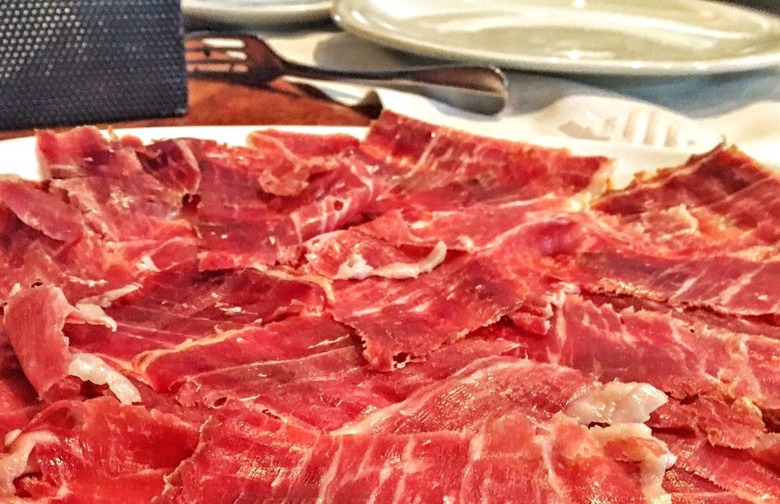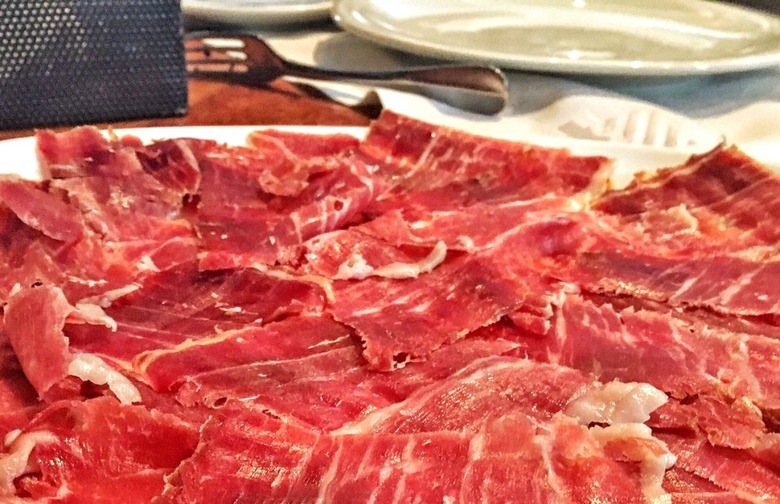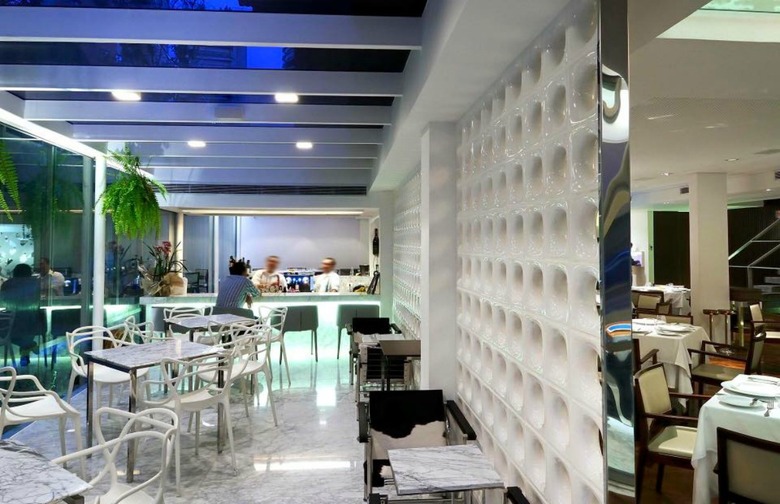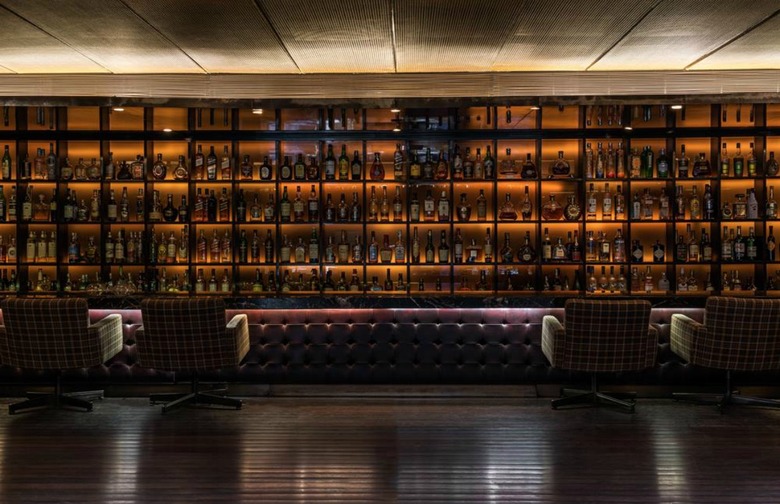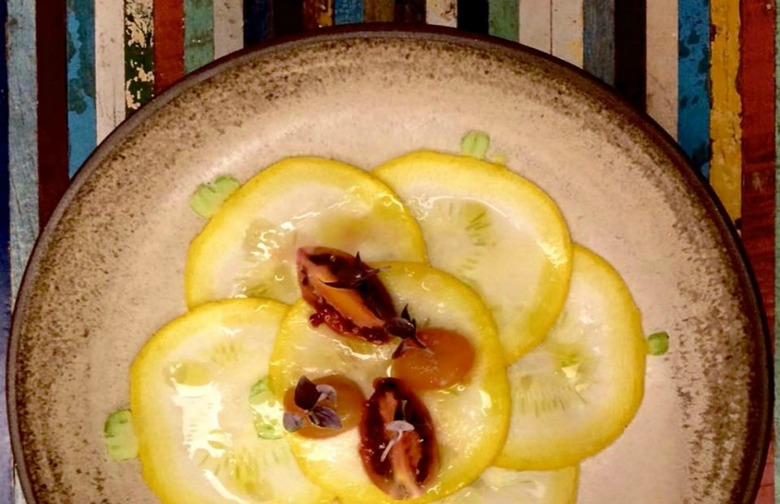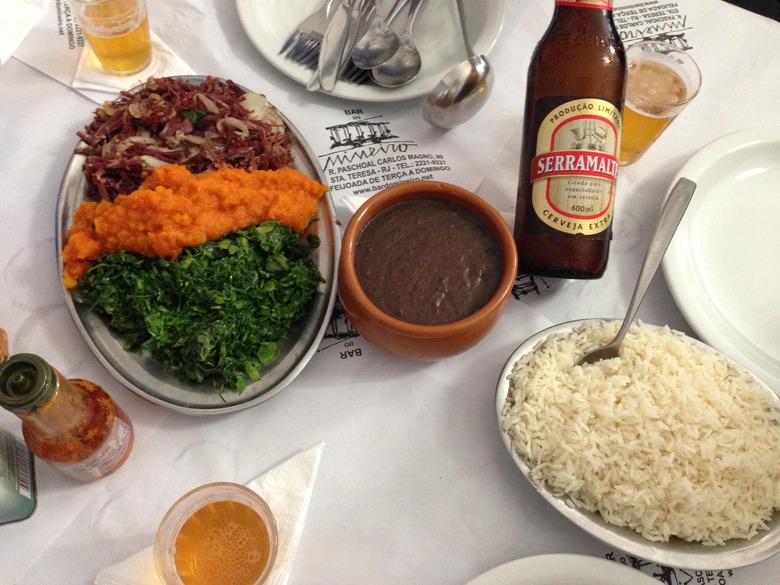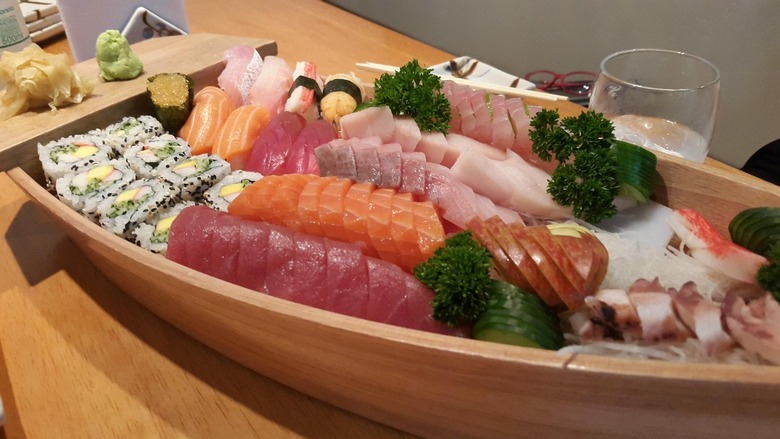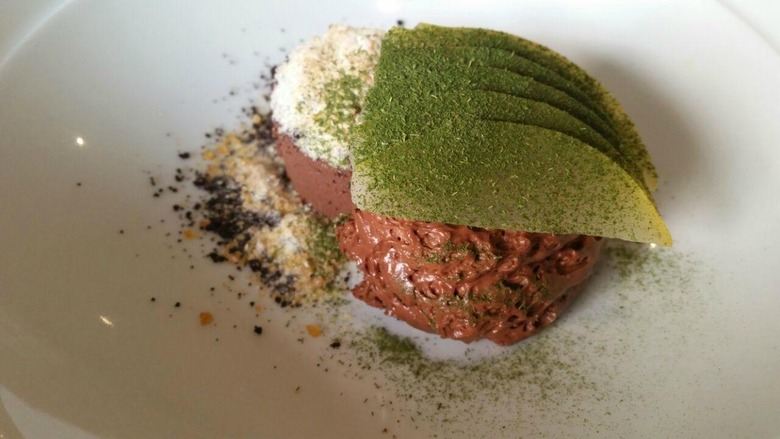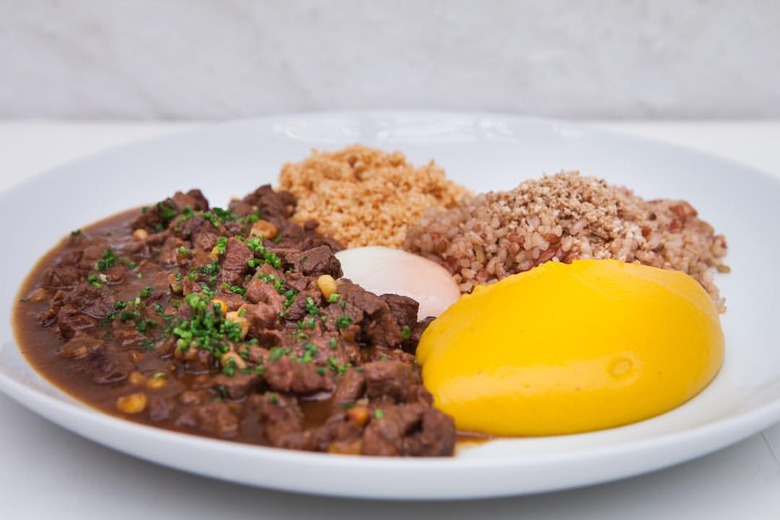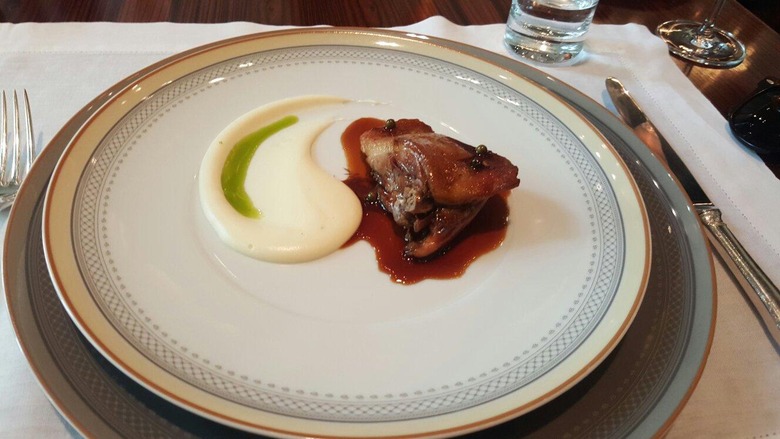20 Best Restaurants In Brazil — Just In Time For The Olympic Games (Slideshow)
#20 Esplanada Grill, Rio de Janeiro
Esplanada Grill is a traditional churrascaria that has kept diners coming back to the Ipanema area of Rio for more than 20 years. The restaurant is small, with tables situated close together, but it has a lively atmosphere to match its terrific offerings. The portions sizes at Esplanada are hearty, so be sure to bring your appetite. On the menu are starters including typical cod fritters, smoked sausage, lamb spare ribs, and chicken hearts. For your entrée, tuck into the incredible selection of quality meats — there are more than 30 cuts on offer — from the grill, especially the picanha (rump cap). Also from the grill are lamb rump, pork tenderloin, ostrich, salmon, and shrimp, among many other dishes to suit a variety of palates. Side dishes might include fried palm hearts, seasoned rice, and a choice of fried, baked, or sautéed potatoes.
Looking for a great Brazilian steakhouse in America? Here are the 15 best.
#19 Attimo, São Paulo
Attimo is where Italian and Brazilian cuisines meet, and chef Jefferson Rueda is the one who organized the introduction. Renowned for his expertise in pork dishes (such as the countryside pork five ways), Rueda also cooks up a mean chicken soup, along with dishes like cassava gnocchi, pumpkin ravioli with mushrooms, slow-cooked oxtail with watercress, and tagliolini with prawns and steak — all featured on menus that change daily. The Michelin-starred restaurant's setting is upscale and modern ,with marble surfaces, and is set in a restored building in the luxurious Vila Nova Conceição area of São Paulo. Be sure to save room for dessert, as pastry chef Saiko Izawa is a star in her own right as well.
Click here for 14 crowd-pleasing pork dishes for when you're the chef.
#18 Le Pré Catelan, Rio de Janeiro
On the western end of Copacabana Beach is the Sofitel Rio hotel, inside of which is Le Pré Catelan. And inside the restaurant is some of the best food in Rio de Janeiro. In fact, as far as French cuisine goes, it's probably the second best in the entire country (with No. 1 to come later). Incredulous? You won't be after diving into tasting menus featuring escargot or foie gras two ways, haddock ravioli with leek and fennel, roasted rack of lamb with spiced confit lamb shoulder, or basically anything on the separate, local, "Menu Amazonia." Dining on fantastic, authentic French food in Brazil is quite the trip, but with chef Roland Villard at the wheel, you're sure to enjoy both the journey and the destination — especially if the destination is the "After Eight" chocolate and peppermint pie with mint tea sorbet.
#17 Fasano, São Paulo
Is this the best Italian restaurant in Brazil? Some would argue so, and that's been the case for decades — after all, the Fasano family has been doing this for 100 years. Fasano's success has brimmed over to other locations, but the flagship, located on the ground floor of the Hotel Fasano, has been top dog since 1982. With its black marble and regal ambience, Fasano is a chic, gorgeous, and spacious white-tablecloth restaurant that draws the beautiful models who you don't believe eat, and will distract you so much that you'll be the one missing out on your meal. Pay attention though, because chef Luca Gozzani's menu offers can't-miss cuisine from the region the Fasanos came from: Lombardy. Duck ravioli, sausage and white bean risotto, pumpkin tortellini, tomato soup with prawns, filetto alla Rossini with foie gras and truffles — it doesn't matter what you pick, it's all exceptional, especially with wine paired by acclaimed house sommelier Manoel Beato.
#16 Cervantes, Rio de Janeiro
Since 1955, Cervantes has been a Copacabana landmark, famous for its trademark meat and pineapple sandwiches. Think pork with pineapple — the classic here — or thinly-sliced filet mignon with pineapple and liverwurst, sandwiched in a perfectly crispy bun. There are more than 25 sandwiches offered, and yes, all of them are finished off with a slice of pineapple. Expect a constant flow of draft beer filling your cup as well. You can choose to eat sitting down at the 72-seat restaurant itself, or head around the corner to its standing-room-only bar for a quick bite.
How about pulled pork sliders with pineapple? Click here for the recipe.
#15 Roberta Sudbrack, Rio de Janeiro
When it comes to Brazil's Roberta Sudbrack (the chef, not the restaurant), it really seems as if she can do it all. Sudbrack is self-taught, cooked at Brazil's presidential palace for seven years, and opened her own restaurant in Rio de Janeiro in 2008 — which now boasts a Michelin star. No surprise there, as Roberta's eponymous eatery changes its exceptional multi-course tasting menus as often as every day based on what's available in the local food markets, and offers different price tiers to meet diner's budgets. Expect to see dishes like house-smoked okra "caviar" with shrimp, dourado fish with tart green corn compote, grouper with onion and roasted pumpkin-seed bouillon, filet of duck, and of course the signature banana ice (which falls somewhere between a sorbet and an ice cream, and is about as fresh as you can get) — all without pretense, in a quaint dining room inside a renovated two-story house.
#14 Kinoshita, São Paulo
Toshio Kinoshita started his eponymous restaurant in Liberdade, the São Paulo district that boasts the largest Japanese community outside Japan itself, more than 30 years ago after having immigrated to Brazil from Hokkaido in the 1960s. It was there that master sushi chef Tsuyoshi Murakami, Kinoshita's son-in-law, perfected his trade, learning how to craft and tweak the kappo cuisine — a style of haute Japanese cooking that aims to marry varying aromas, textures, and ingredients to take diners on a culinary journey as chefs prepare dishes at an open counter — with surprising flourishes. Kinoshita offers sushi at the highest level in São Paulo, and the menu here is constantly changing based on the freshest catch available. Today, with the restaurant transplanted to south São Paulo's Vila Nova Conceição district, Murakami offers a choice between à la carte and seven- or nine-course tastings, featuring immaculately plated dishes such as grilled scallops with green onions and butter; whitened bean sprouts with pancetta and ponzu sauce; tuna sashimi portobello mushrooms and roe; and a long selection of yakimono, which are grilled or pan-friend dishes, including grilled lamb with teriyaki or ribs marinated in miso and grilled with teriyaki.
#13 Lasai, Rio de Janeiro
Although the name Lasai means "tranquility" in the Basque language, it's hard to experience all the restaurant has to offer without getting overly excited. In fact, food critics jumped to praise the Rio restaurant as soon as it opened in 2014, tucked inside a house built in 1902. In regard to the food, much of it starts at the farm of chef Rafael "Rafa" Costa e Silva. Dishes include coconut-yam cream with egg yolk and salted air-dried beef strip, pulled braised oxtail on homemade brioche rolls, and scallops with marrow and herbs. There are two menu structures: Don't Mess With Me (guests can choose their own combinations) or Festival (chef's choice). The dining room is airy and wood-adorned, with the central product of the day (corn, carrots, cassava, etc.) displayed under a glass dome on each table. With this fantastic cuisine it's no wonder Lasai is the proud owner of a Michelin star. And speaking of wonders, it's probably worth mentioning that the terrace features views of one of the Seven Wonders of the Modern World: Rio's Christ the Redeemer statue.
#12 Olympe, Rio de Janeiro
Run by French-born father-and-son duo Claude and Thomas Troisgros, of the famed Troisgros restaurant dynasty, Olympe expresses French and other European culinary ideas through Brazilian ingredients. Among the specialties served in the warmly furnished dining room, with its walls of dark wood and brick, are shrimp risotto with white truffle oil and mushroom foam; lamb tenderloin with an açai crust; tuna tartare with red sugar beet and fois gras; grilled beef tenderloin in a rosemary and green peppercorn crust in a red wine sauce; roasted sea bass with fresh heart of palm, celery and lemon confit, and haddock consommé; 48-hour roast beef with beans and blueberries; crunchy suckling pig confit with panko-cacao nibs farofa and slow-cooked Fuji apples; and deconstructed guava cheesecake.
#11 Remanso Do Bosque, Belem
With a name that translates to "quiet place in the woods," Remanso do Bosque isn't just trying to be creative; the restaurant actually uses local produce straight from the nearby forest or its own kitchen garden using indigenous techniques. Chef Thiago Castanho changes his tasting menu constantly — past staples have included Amazonian chargrill fish, moqueca stew, wild duck with tucupi (a manioc root sauce), and his signature savory-sweet açaí farofa (toasted cassava flour). Always aiming to embrace innovation, Remanso do Bosque even brings in the occasional guest chef to create unique tasting menus using local ingredients.
#10 Bar do Mineiro, Rio de Janeiro
On your next trip to Rio (or just as an added excuse to visit one of South America's most popular destinations), set aside some time to visit Bar do Mineiro. This lively Rio joint can be found near the top of the Santa Teresa hill in the center of the city, an area famous for its winding, narrow streets, through which you can meander to work up your appetite. A restaurant as well as a bar, Mineiro serves generous portions of feijão tropeiro (beans with sausage, served over rice), an assortment of pastéis (deep-fried pastries filled with cheeses, beans, and meat) that are considered to be among the city's best, and cachaça (a sugar cane spirit). The meatier dishes, including the traditional Minas sausages served with butter-cooked cassava, have also developed a dedicated fan-base, making Bar do Mineiro the place to see and be seen in this artsy neighborhood.
#9 Casa da Feijoada, Rio de Janeiro
The restaurant's namesake feijoada, a hearty arrangement of beans and pork that is considered Brazil's national dish, is traditionally eaten only on Saturdays. However, Casa da Feijoada has been serving the best feijoada in the city every day of the week for the past 25 years. At this small, intimate eatery on a bustling corner in Rio's Ipanema neighborhood, this dish is the main event, and is served with traditional sides, including orange slices, farofa (manioc flour sautéed with butter), fried couve (spring greens), and grated kale. Be sure to order a caipirinha, and enjoy what will most likely be one of the most definitively Brazilian experiences you'll ever find.
#8 Dalva e Dito, São Paulo
Chef Alex Atala of São Paulo's D.O.M. prepares simpler, more traditional food at this casual offshoot of his flagship, but the quality is first-class. From the light but savory pão de queijo ("cheese bread," actually a gougères-like manioc-flour pastry flavored with cheese from Minas Gerais), arguably the best in town, to the dense pudim de leite (flan), everything is prepared with great skill and consistency. Other homey fare includes such dishes as roast duck in manioc sauce, roast leg of goat, and a textbook-perfect interpretation of moqueca capixaba, a traditional seafood stew from the state of Espírito Santo made in a black clay pan. The array of caipirinhas offered is dangerously delicious.
Pão de queijo is considered one of the world's best comfort foods. See 14 others by clicking here.
#7 Ostradamus, Florianópolis
If fans of Brazil's Ostradamus had to make a one-word recommendation about the restaurant, it would simply be "oysters." Served in a multitude of different ways (such as raw; with oil, parmesan cheese, and tomato; or gratinada ), the eatery is world-renowned for its melt-in-your-mouth oysters, as well as other seafood dishes like crab risotto, steamed shrimp, mussels, and octopus. We'd recommend asking for a table with a view, but since the restaurant is located on a dock, the scenery is spectacular no matter where you sit.
Should you be afraid of oysters? We have the answer right here.
#6 Mocotó, São Paulo
About a 40-minute drive from the center of São Paulo, in the district of Vila Madeiros, is an eatery that is genuinely worth waiting in line for — which you'll almost certainly have to do, though with a caipirinha in hand. (Mocotó is famous for fashioning its caipirinhas from artisanal cachaças.) Mocotó first opened in the 1974 as a small neighborhood eatery and steadily grew to become one of the best restaurants in Brazil. Run by the impressive Rodrigo Oliveira and his father, José, who started the restaurant, Mocotó offers diners a taste of the cooking of Pernambuco, the northeastern Brazilian state where the Oliveira family originates. In fact, the restaurant's name is also that of a popular calf's foot soup from that region. You'll find nothing but traditional dishes here, all of which Rodrigo Oliveira executes with the utmost precision. Must-order items include the signature caldo de mocotó, made from an old family recipe; baião de dois, Brazilian "rice and beans," made with curdled cheese, sausage, bacon, and jerked beef; and homemade salt-cured beef served with clarified butter, roasted garlic, sweet peppers, and cassava chips. For dessert, you'll find ice creams and compotes made with tropical fruits as well as in-house creations such as chocolate mousse with cachaça.
Ever wonder why rice and beans are so popular in South America? Click here for the scoop.
#5 Sushi Hiroshi, São Paulo
This two-floor, 100-seat restaurant located on a quiet street in São Paulo is easy to miss. Sushi Hiroshi is locally considered a must-visit restaurant for sushi in the city, which has a huge Japanese population. The atmosphere is warm and friendly, the service exceptional, and the dishes well-prepared and creative. On the menu is a variety of sushi and sashimi, some that stray from the more traditional side of Japanese cuisine, with house favorites including sushi ebiten, or nigiri breaded shrimp with sweet and sour sauce and mayonnaise; sushi ciro, with salmon, green onions, and breaded shrimp; and the Romeo, made with tuna or salmon in sesame crust, fried cabbage, and pepper jelly.
#4 Epice, São Paulo
After working under some of the world's top chefs — including Gordon Ramsay in London and Pierre Gagnaire in Paris — Alberto Landgraf came home to Brazil with a vision: to give authentic Brazilian flavors a modernist makeover. The result is Epice, a cozy, warmly lit restaurant in São Paulo's stylish Jardim Paulista neighborhood where Landgraf practices some serious culinary magic in the kitchen. His tasting menu descriptions are minimalist — dried cassava and cured pork belly, quail egg and fresh seaweed, fried pork ear — but the dishes are intricately fashioned and often brilliant. Landgraf's sense of contrasting flavors and textures is superb, paving the way for Epice's creative dishes like scallops served with pickled carrot, or cubes of cold carrot jelly served with luscious warm carrot purée. The à la carte menu ranges from the seemingly-mundane elevated to the gastronomic (a plate of pumpkin gnocchi, sautéed pumpkin, pumpkin cream, Parmesan gelatin, and shimeji mushrooms) to the unlikely (grilled octopus with sweet corn, black garlic, broccoli, and vegetable broth) to the luxurious (foie gras with green corn, farmer's cheese, endive, and sorrel).
#3 Jun Sakamoto, São Paulo
This city is home to the largest Japanese community outside Japan, so it's quite something for a chef to be singled out as São Paulo's best sushi master, but here, Jun Sakamoto is the king. This discreet restaurant (which Sakamoto designed) seats just 35 people in its long leather banquettes — though for a price, eight patrons can have Sakamoto serve the restaurant's high-quality fish to them directly at the sushi bar. Among the signature dishes here is tartar de atum com foie gras (tuna tartare with foie gras) and vieiras come sal trufado (scallops with truffle salt).
#2 Maní, São Paulo
Husband-and-wife team Daniel Redondo and Helena Rizzo both spent time at El Celler de Can Roca in Girona, Spain (Redondo was born in that city), hailed as "the best restaurant in the world," and the true heir to the culinary throne after the closing of elBulli. Redondo and Rizzo have now made their own mark, using what they learned in Spain and incorporating its culinary influences with those of Italy and Brazil. What to expect at Mani? Among many other delicious and unusual dishes, curried quinoa balls with celery jam; octopus sticks with confit potatoes and sweet paprika; cold soup of jabuticaba (a Brazilian "superfruit") with cachaça-steamed crayfish, pickled cauliflower, and amburana nuts; lightly grilled tuna with quinoa, blackberry chutney, ginger foam, and shiso peppers; and sweet smoked eggplant with curdled goat milk, lime zest, orange flower jelly, pistachios, crispy shredded phyllo, and black sesame seed ice cream. There is also a skillfully-designed nine-course tasting menu.
Click here for more about jabuticaba, and 9 other exotic fruits worth traveling for.
#1 D.O.M., São Paulo
The amiable, heavily tattooed Brazilian chef named Alex Atala has galvanized his country's food scene and is one of the most original and influential chefs in South America. His showplace, D.O.M. — the initials stand for Dominus Optimo Maximo, which might be translated from the Latin approximately as Lord Almighty (in the religious, not the exclamatory, sense) — is a small place with 50 seats, high ceilings, cool beige walls, bare wood tables set with linen placemats, and a Philippe Starck chandelier. The food Atala cooks is unmistakably Brazilian, though created through the filter of a classical culinary education and wide experience of the world. Chibé is a kind of manioc flour mush eaten by native tribes in the Amazon; Atala reinvents it as a tabbouleh-like salad flavored with a dozen Amazonian herbs and blossoms, each with a different taste. Lightly toasted black rice mixed with bits of broccoli, celery, corn, scallions, and parsnips is moistened with Brazil nut milk. Salt cod — that favored fish of Brazil's Portuguese colonizers — is sauced with a "mayonnaise" made with milk and cabbage. Hearts of palm are turned into fettuccine, flavored Italian-style with butter, Parmigiano-Reggiano, sage, and popcorn powder, or served as "carpaccio" with scallops and basil oil. Skate is combined with peanut foam and smoked mandioquinha, or "little cassava," in fact an ancient Andean root (Arracacia xanthorrhiza) sometimes said to resemble a cross between carrot and celery. Desserts might include a Brazil nut tart with whiskey ice cream, chocolate, salt, and pepper, and a few leaves of a very popular green here: arugula. It is safe to say you won't find food like this anywhere else in the world.
